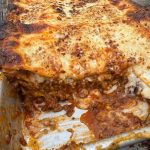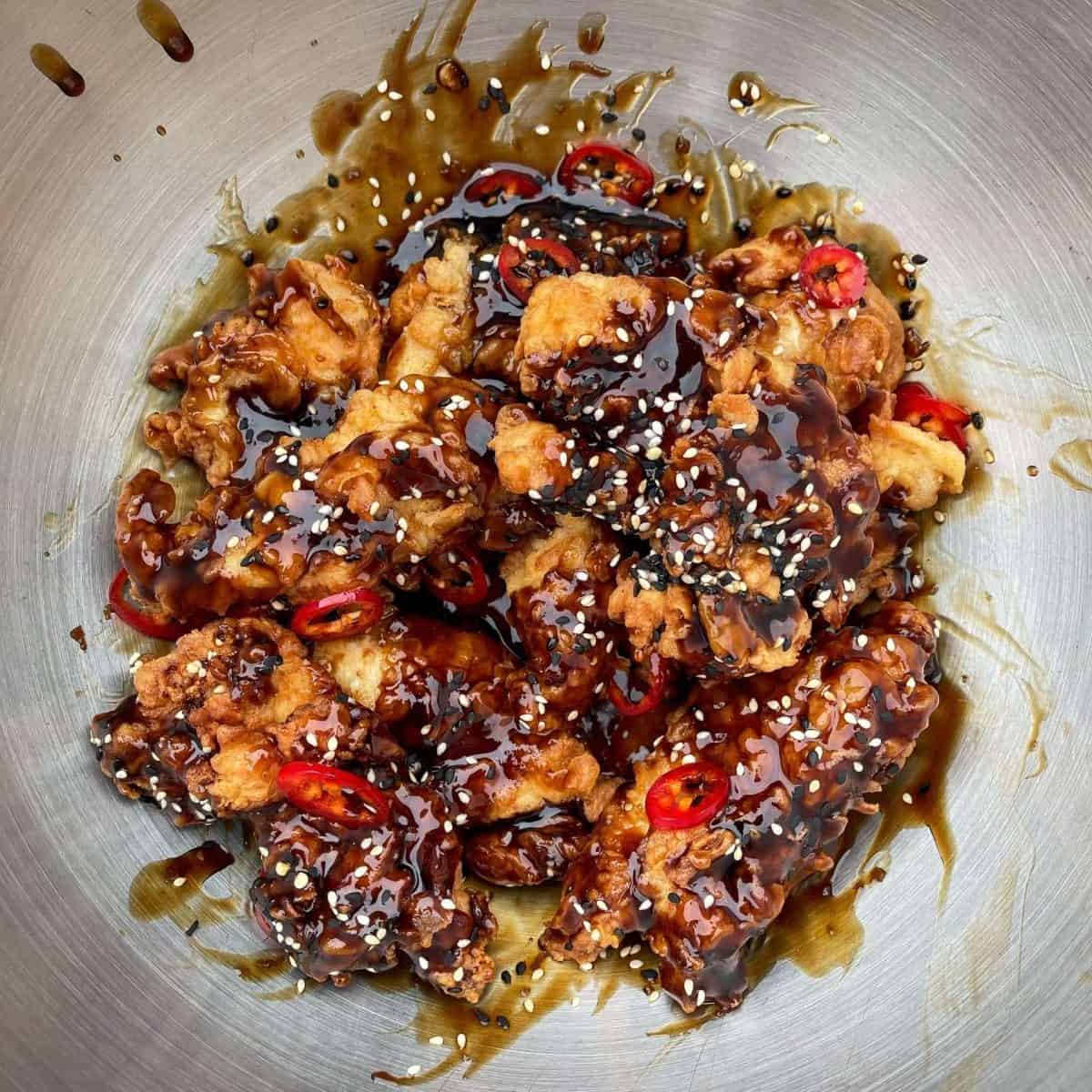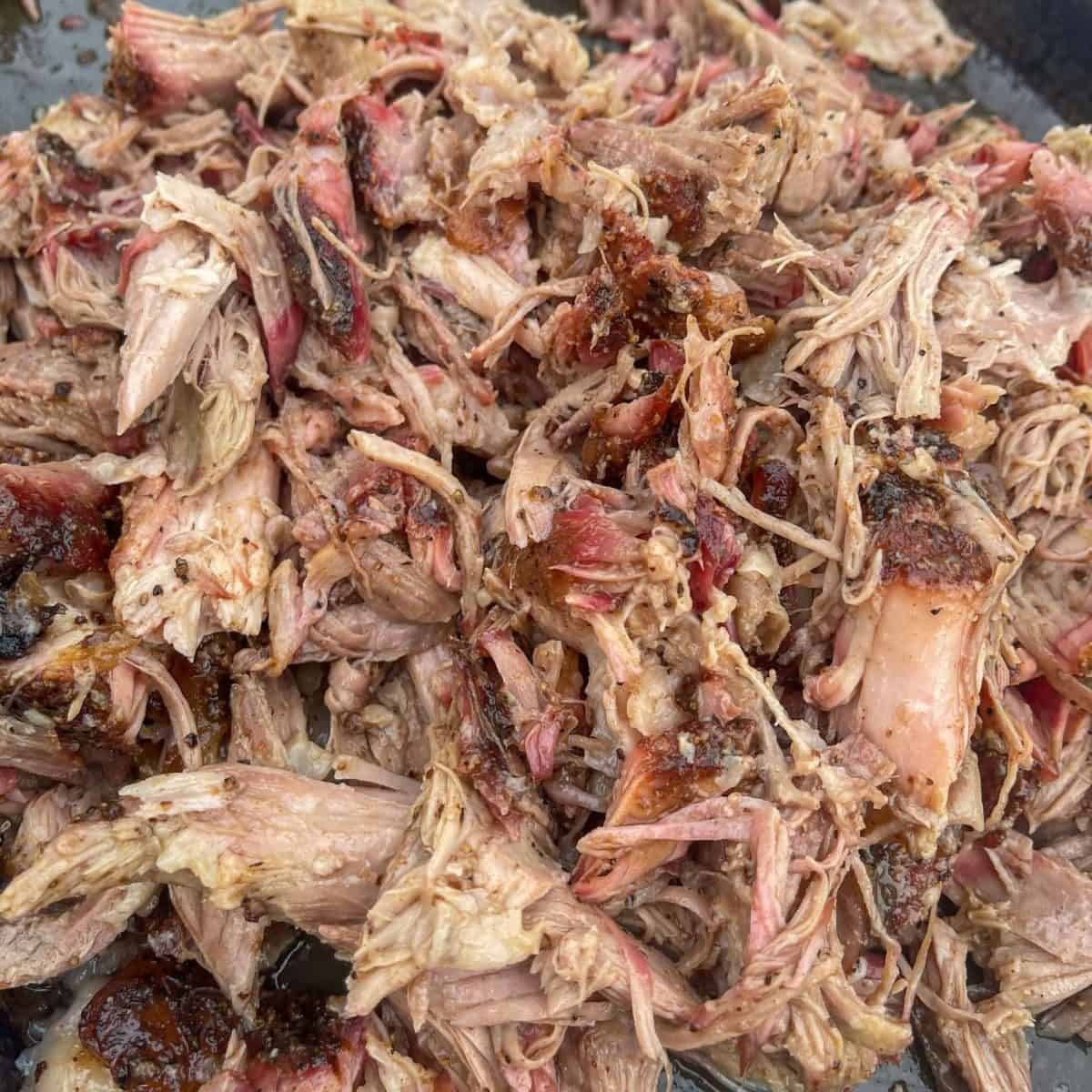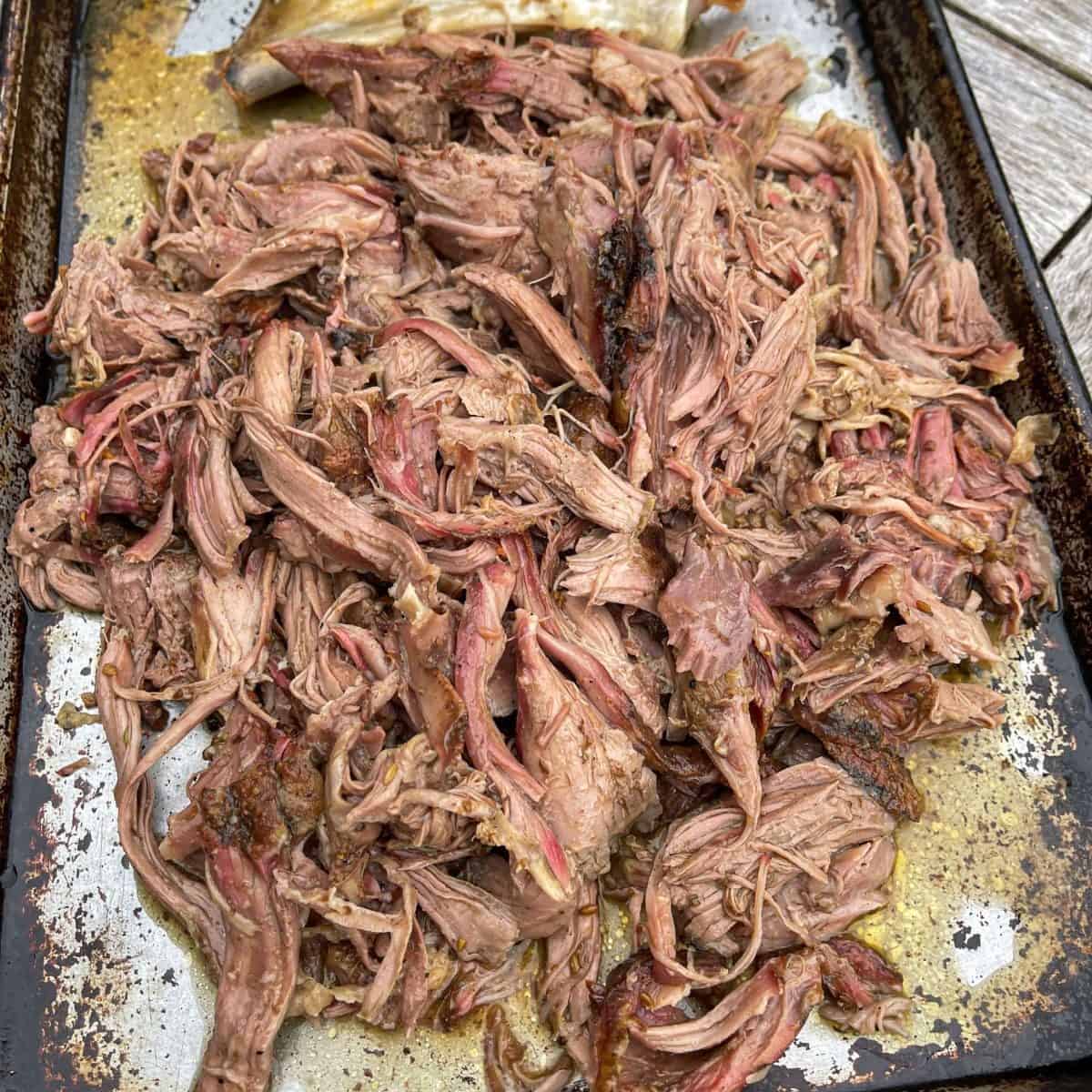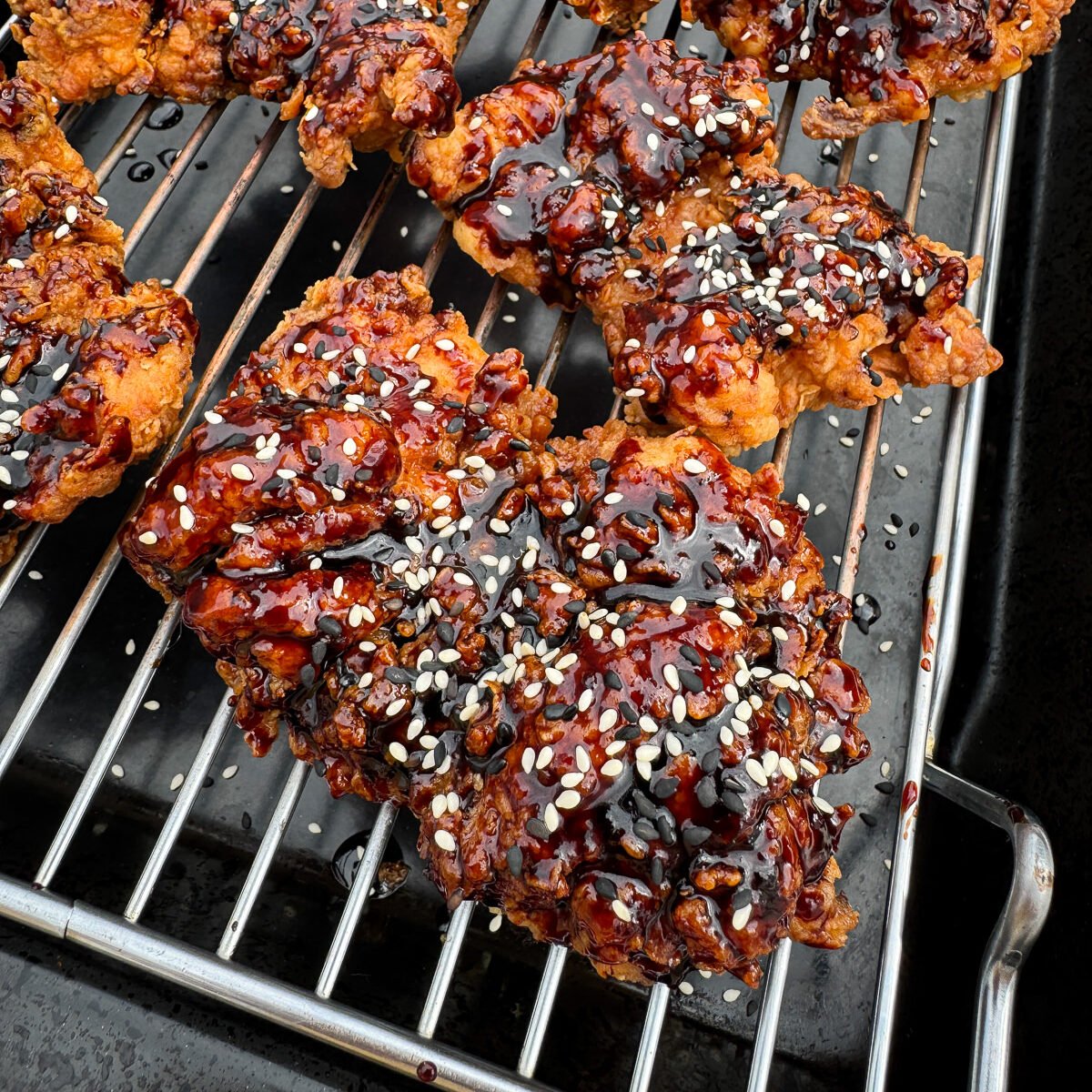Roasted Garlic Lasagne (Deep Dish)
This deep dish roasted garlic lasagne is the ultimate comfort food! There’s a rich ragù bolognese, a punchy roasted garlic bechamel, homemade lasagne sheets & plenty of cheese.
This post contains affiliate links.
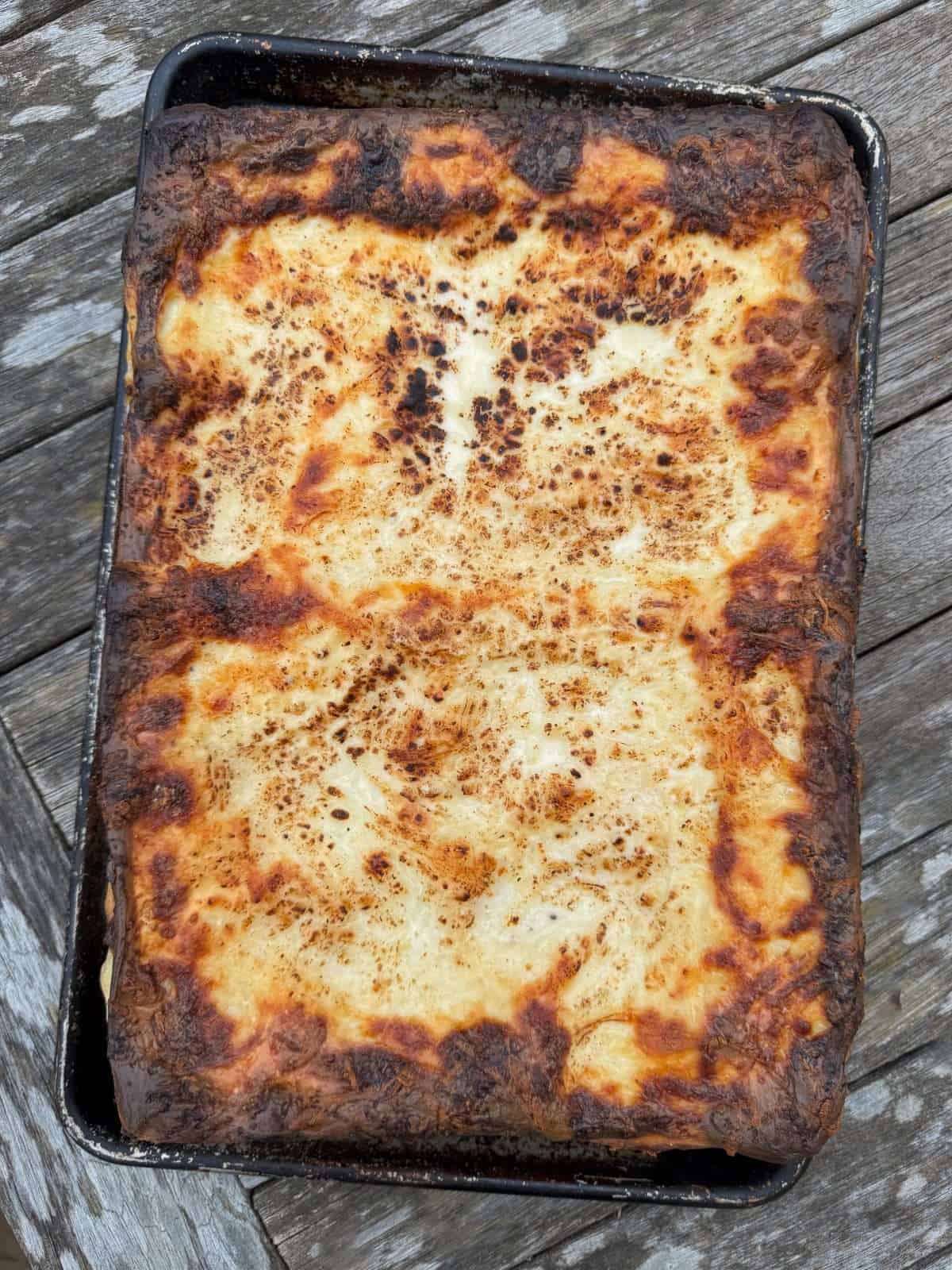
I LOVE lasagne! It’s one of this dishes that takes a decent chunk of time to make but it sure is worth it. Pair it with some garlic bread & a simple salad & you’re onto a real winner.
We’re making this lasagne completely from scratch. This includes a slow cooked ragù bolognese, the creamy bechamel sauce that’s flavoured with nutty roasted garlic & even the lasagne sheets (although this is optional). These are all layered up in a deep baking tin, topped with grated mozzarella & parmesan then baked until crisp & golden.
This lasagne’s rich, creamy & absolutely jam packed full of flavour. It will easily feed a crowd & is a guaranteed winner!
For more dinner inspiration, take a look at our ever growing collection of main course recipes! There’s lots to choose from here, from homemade pasta, to slow cooked stews, pies, steaks & more…
Ingredient Notes
- Mince – I used both beef & pork mince for my ragù but feel free to just use beef if you’d prefer. I find that using a 50/50 mix of beef & pork gives the bolognese more flavour & a better texture.
- Pancetta – I like to use smoked pancetta in my ragù but unsmoked will work as well. If you can’t find pancetta, streaky bacon will work instead.
- Red Wine – Don’t worry about using an expensive wine! A Merlot or Malbec will work well. If you’d prefer to not use wine, use beef stock instead. White wine will also work but will give the ragù a lighter flavour.
- Stock – You’ll need 2 types of stock for this lasagne. Beef stock pots (or cubes) for the ragù & some chicken stock for the bechamel (this replaces some of the milk to give the bechamel a deeper flavour).
- Tomatoes – Good quality tomato paste & tinned tomatoes make all the difference when making bolognese. I like to use Mutti tinned chopped tomatoes but plum tomatoes will work as well, although they’ll need to be broken up with a spoon as you cook the ragù.
- Milk – Adding milk to bolognese helps tenderise the meat & cuts through the acidity from the tomatoes. I find that whole milk works best but semi skimmed will do the job as well.
It’s important not to boil the bolognese after adding in the milk otherwise the sauce will split. - Cheese – This lasagne uses parmesan & low moisture mozzarella, which are both available in supermarkets. To make the mozzarella easier to grate, pop it in the freezer for 30 minutes first!
- Flour – If you’re making your own lasagne sheets, you’ll need 00 flour. You’ll also need some fine semolina, to dust the pasta sheets so that they don’t stick together. For the bechamel, you’ll need plain flour.
- Eggs – Our homemade pasta dough uses a combination of whole eggs & egg yolks. We’re using large eggs, which weigh around 50 grams out of the shells.
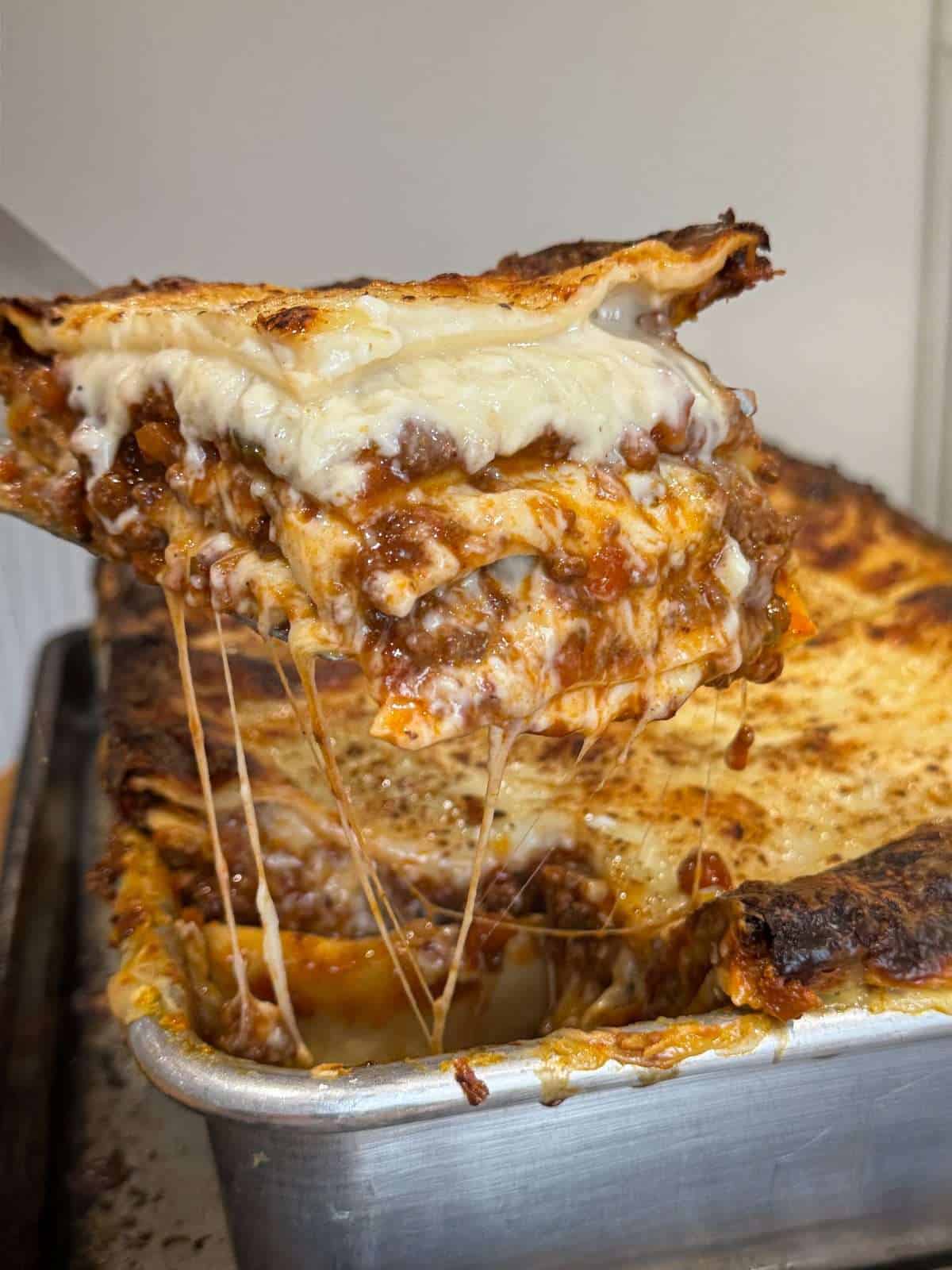
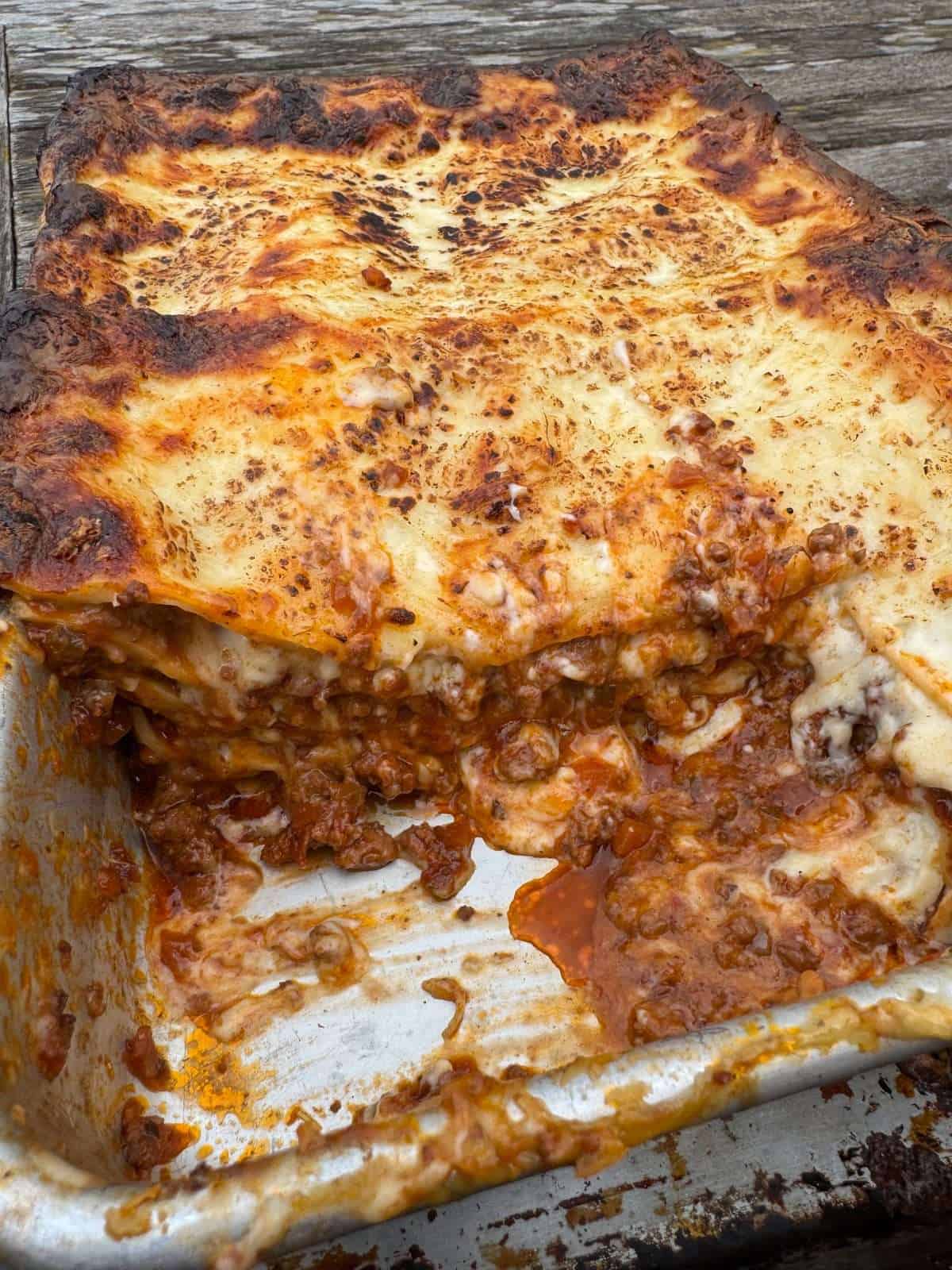
Lasagne Components
This deep dish lasagne has all the classic components but with a couple of upgrades! We’re talking a rich, slow cooked ragù bolognese sauce, a creamy roasted garlic & parmesan bechamel sauce, homemade lasagne sheets & plenty of grated cheese.
Ragù Bolognese
Like all good lasagnes, this one starts with the ragù bolognese sauce. And for the best tasting ragù sauce, we’re going to be cooking it the day before we make the lasagne, so that the flavours can develop in the fridge.
I used my slow cooked bolognese recipe as the base for this ragù but with some small adjustments to make it perfect for this lasagne. The main change is that I used half beef mince & half pork mince for the lasagne, instead of just beef. This is a more authentic way to make a ragù & gives the perfect texture & flavour. The key to making the best ragù bolognese sauce, is to properly brown off the meat, deglaze the pan with wine & simmer the sauce for several hours, until thick & rich. Other than that, it’s super easy to make!
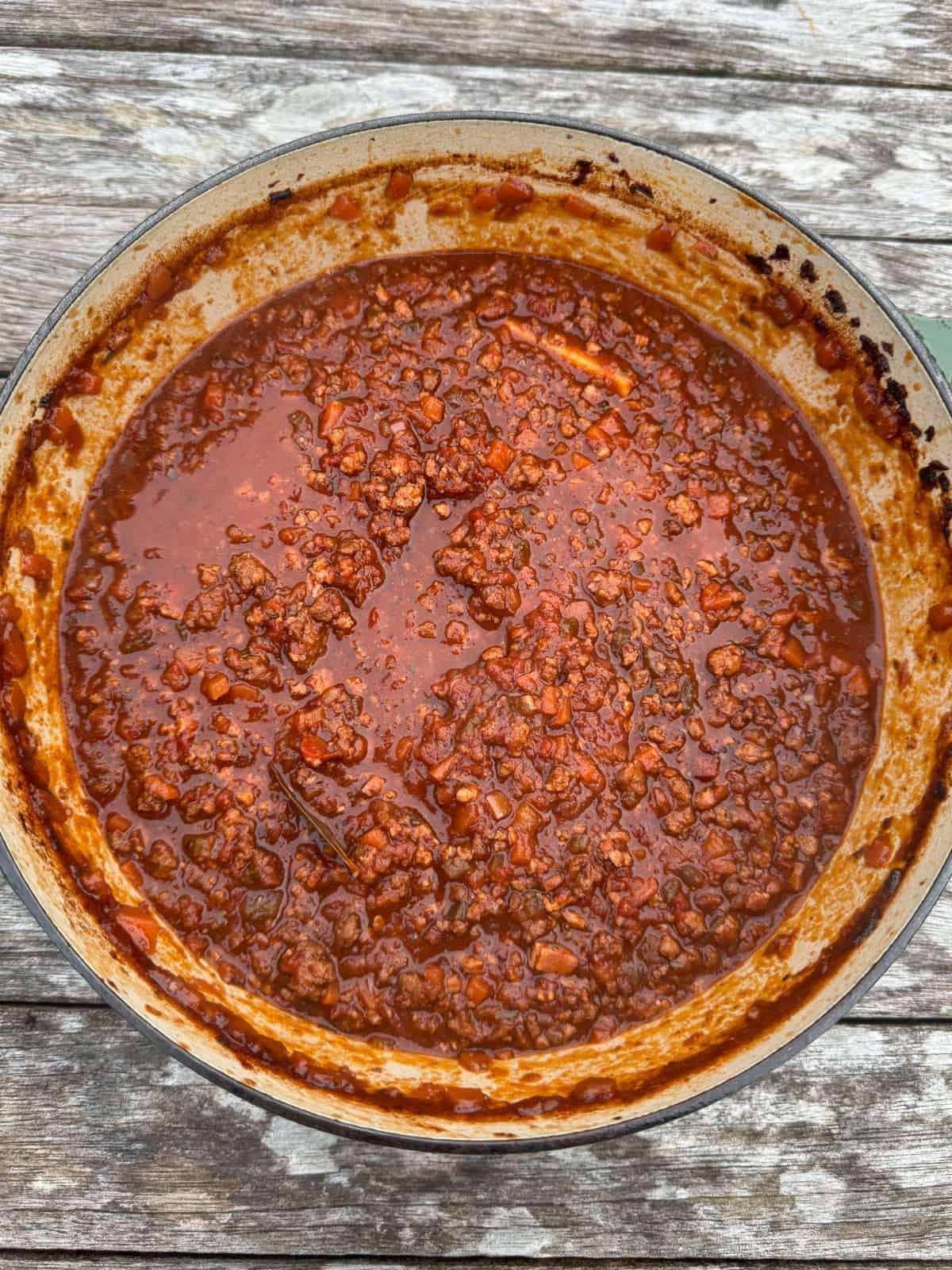
Roasted Garlic Bechamel
We’re making a classic bechamel sauce that’s flavoured with parmesan cheese & nutmeg then we’re blending plenty of roasted garlic into the sauce at the end, for extra flavour! This bechamel adds another level of flavour to our lasagne, as well as creaminess.
Roasted Garlic
To roast the garlic for our sauce, we cut the tops off a couple of whole bulbs, drizzle them with oil & season with salt & pepper. Each bulb of garlic then gets wrapped in foil then they get roasted at 180°c/356°f for around an hour, until the cloves are soft.
Bechamel Sauce
Our bechamel sauce is made the classic way, by thickening milk with a roux. However, we’re also going to be replacing some of the milk with chicken stock, to give the sauce a richer flavour. Once the sauce has been cooked out, we stir in plenty of grated parmesan & nutmeg (to taste) then season with salt & pepper.
To finish the bechamel, we squeeze roasted garlic out of the skins then use a stick blender to blend it into the sauce. You can add as much roasted garlic into the sauce as you like here! It’s best to add the roasted garlic in, to taste.

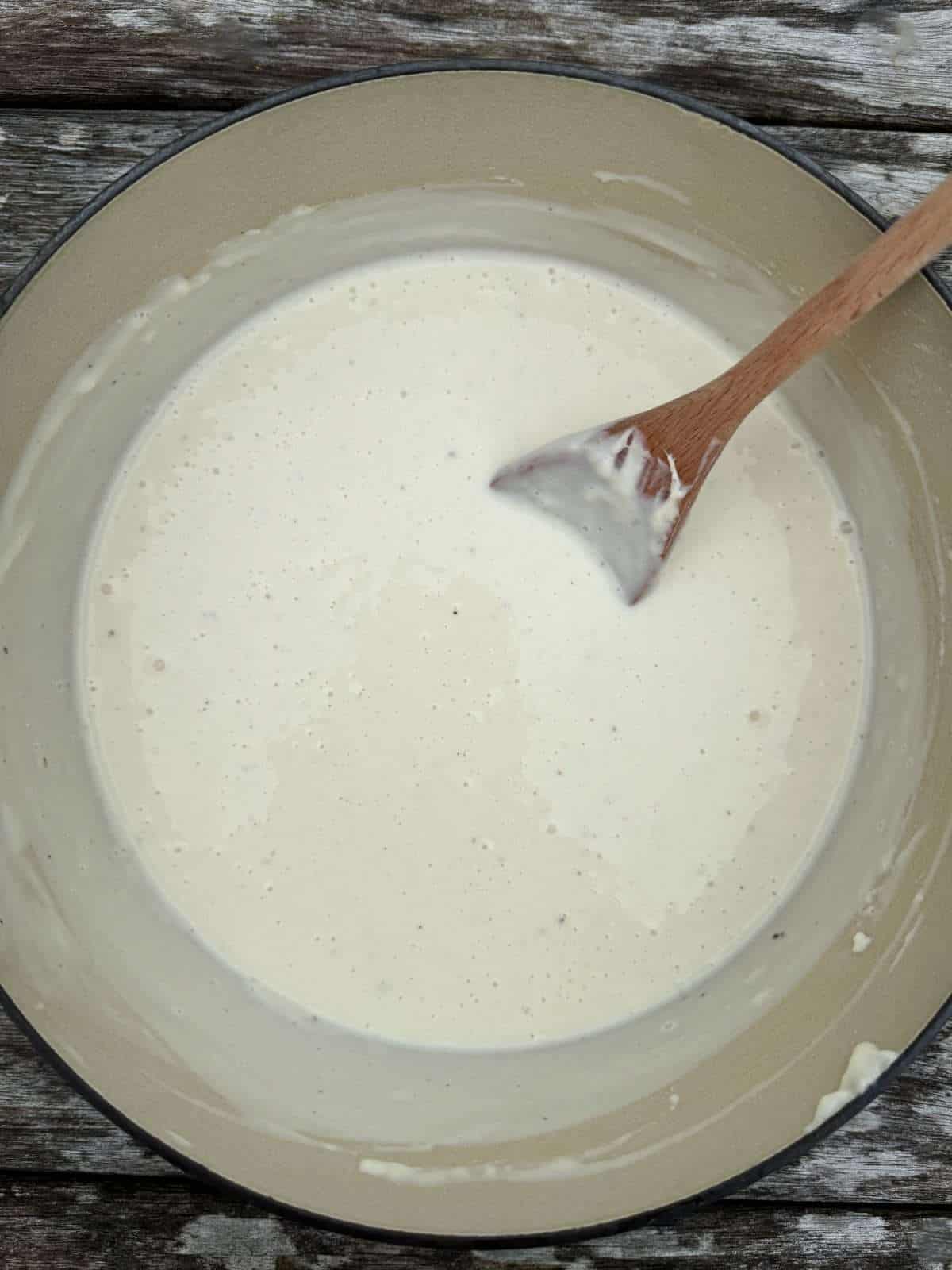
Homemade Lasagne Sheets
We’re making the rest of this lasagne from scratch so we might as well make some homemade lasagne sheets as well right?! Homemade pasta sheets do take a bit effort to make but they’re actually really easy to prepare & really do make all the difference with homemade lasagnes.
To make our homemade lasagne sheets, we make a simple pasta dough with 00 flour, whole eggs & yolks, let it rest for a few hours in the fridge then roll it out with a pasta machine to a thickness of 1mm then cut into sheets. I then like to blanch the pasta in boiling salted water before assembling the lasagne, as I find this make them easier to work with but this is optional.
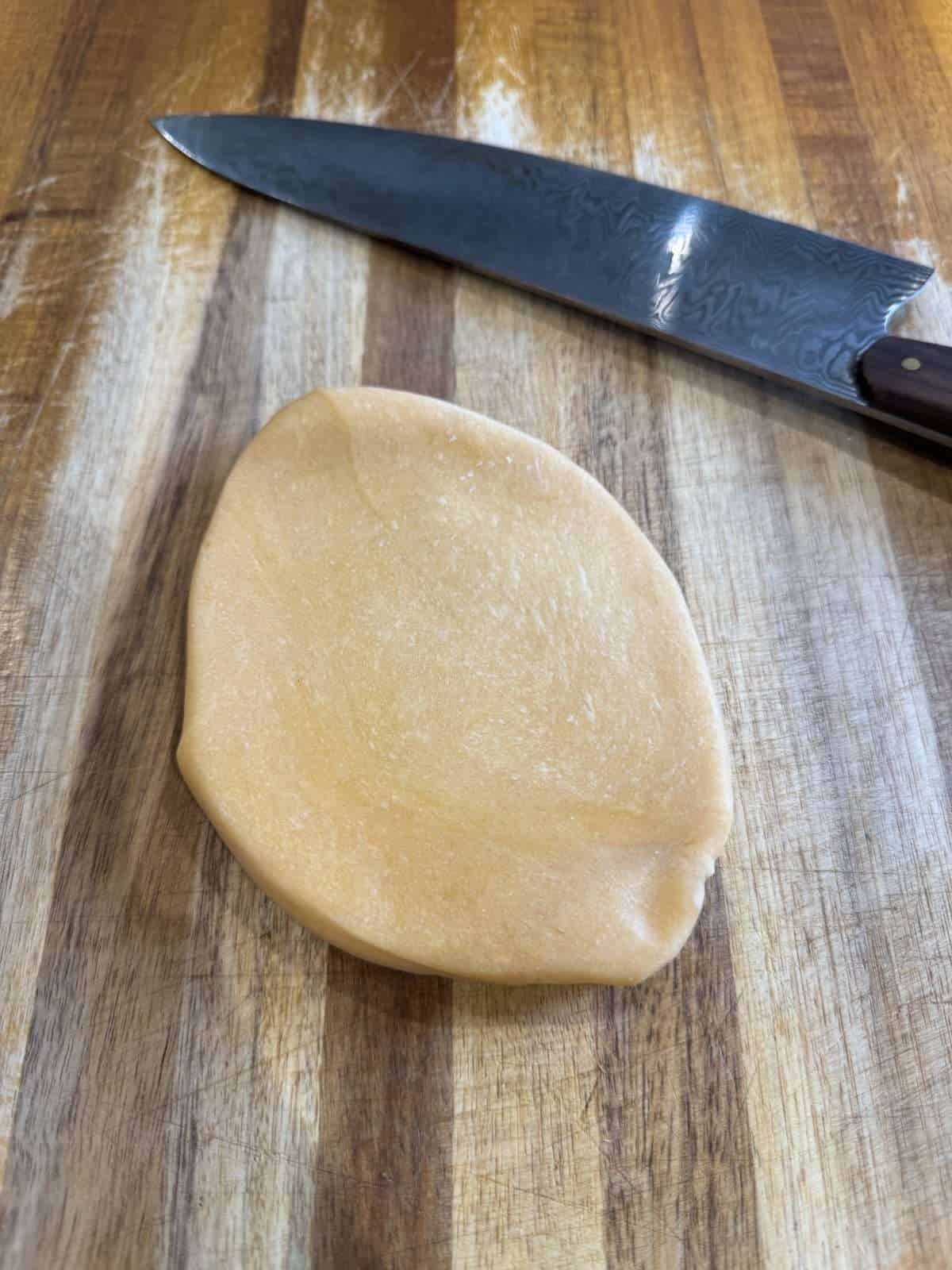
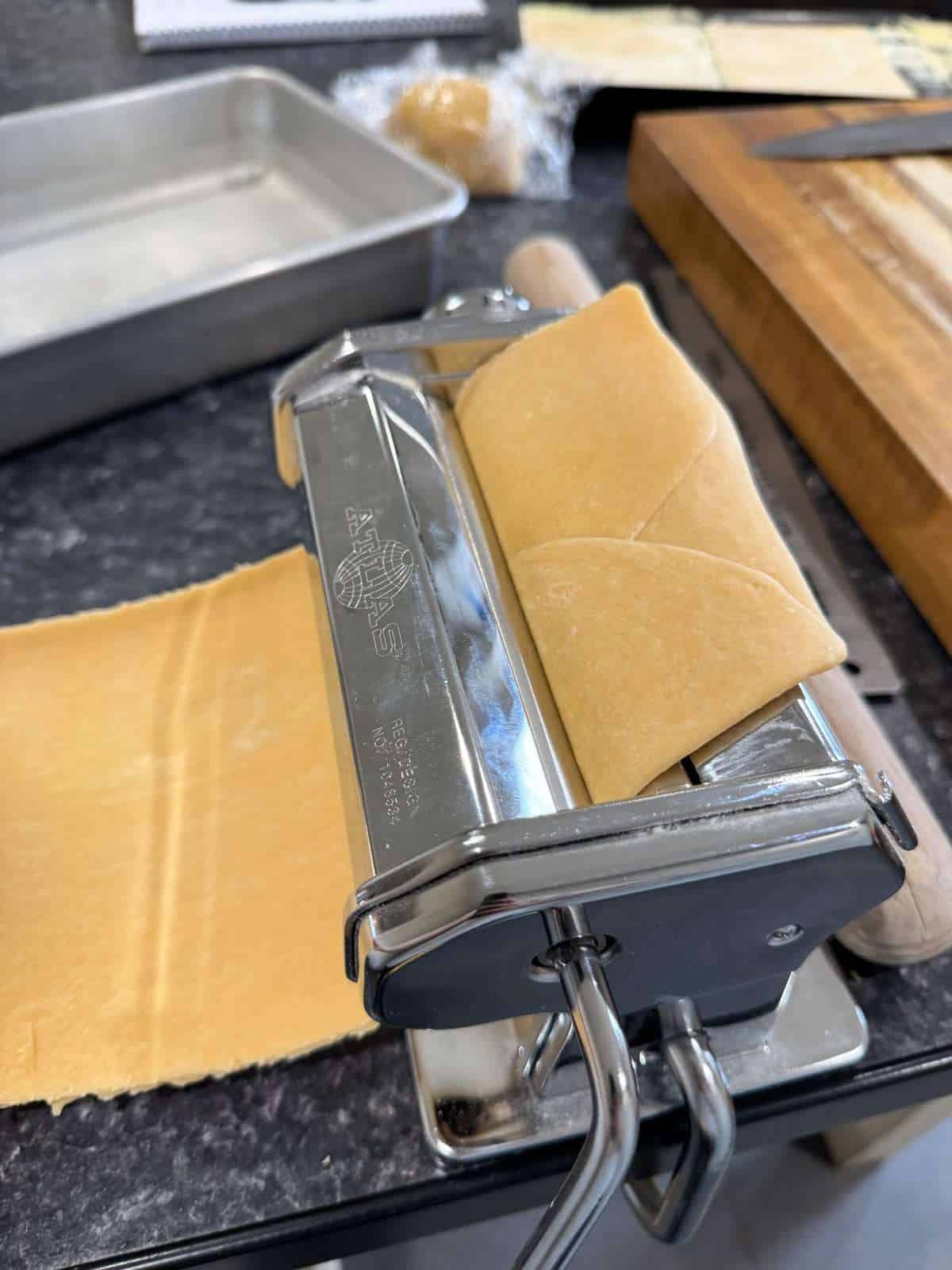
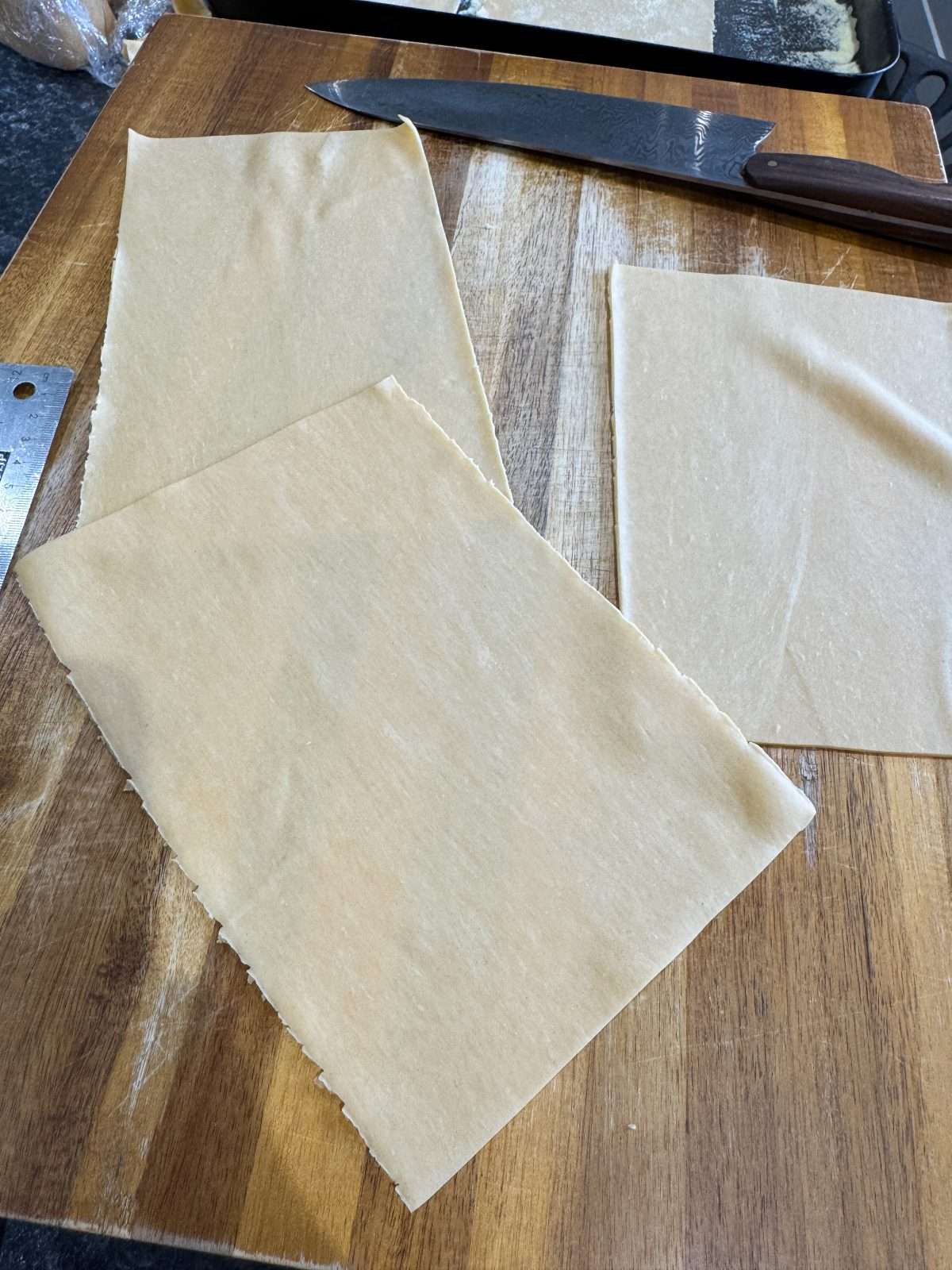
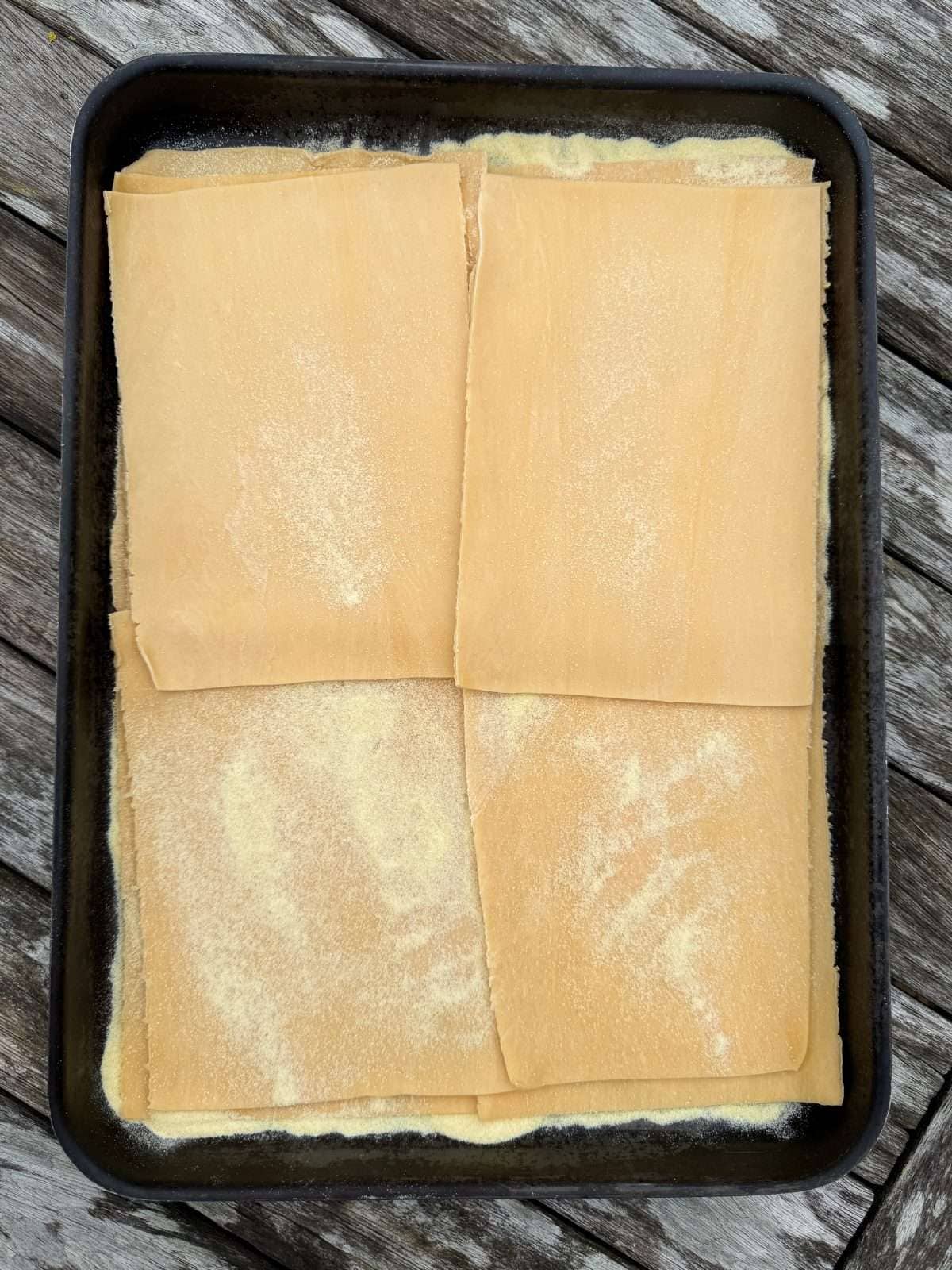
Cheese
I used 2 cheese for this lasagne; parmesan & a low moisture. I find that this gives the best balance of flavour & colour (it goes a deep, golden brown on the top layer). However, for a more authentic lasagne, you could use ricotta as well.
How To Assemble Lasagne
This deep dish lasagne has 5 layers of each component, which we’re layering up in a 9″x13″ baking tin. This includes a thin layer of ragù on the base to stop the pasta sheets moving around & a layer of just bechamel & cheese on top, which gives the lasagne a crisp, golden topping!
- Grease a 9″x13″ baking tin with butter then spread a small amount of the ragù on the bottom. This stops the lasagne sheets from sliding around!
- Top the ragù with a single layer of lasagne sheets then spoon a quarter of the remaining ragù on top, spreading it out into an even layer that completely covers the pasta.
- Next, spoon a generous amount of the bechamel over the ragù then top with a sprinkle of grated mozzarella & plenty of grated parmesan (use a microplane to grate the parmesan over the lasagne!).
You’ll need to use roughly 1 fifty of the bechamel, grated mozzarella & parmesan per layer. - Continue layering up the lasagne in the same order until you’ve used up all of the pasta sheets, ragù, bechamel & cheese. The top layer should just be bechamel & grated cheese (no ragù).
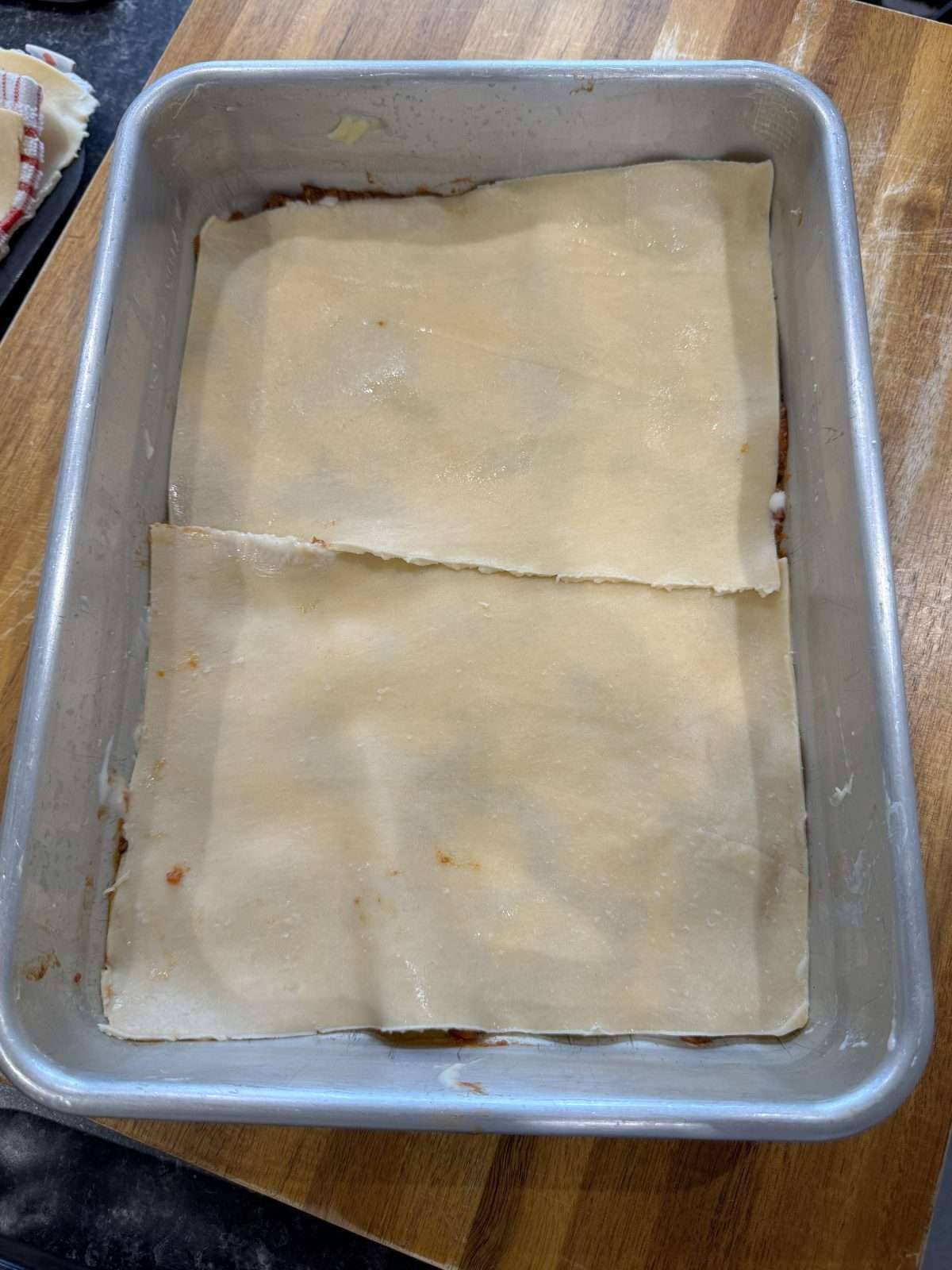
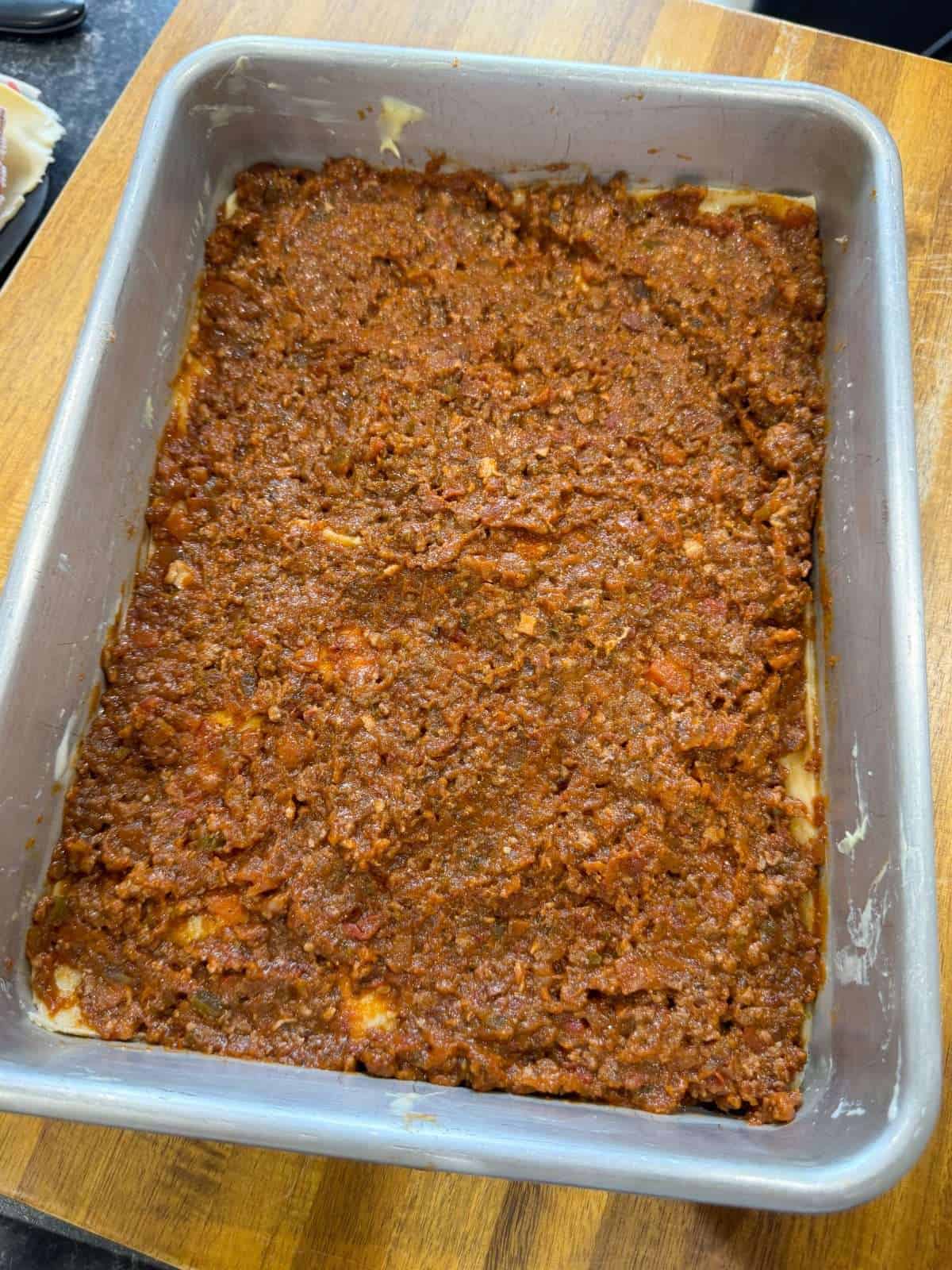
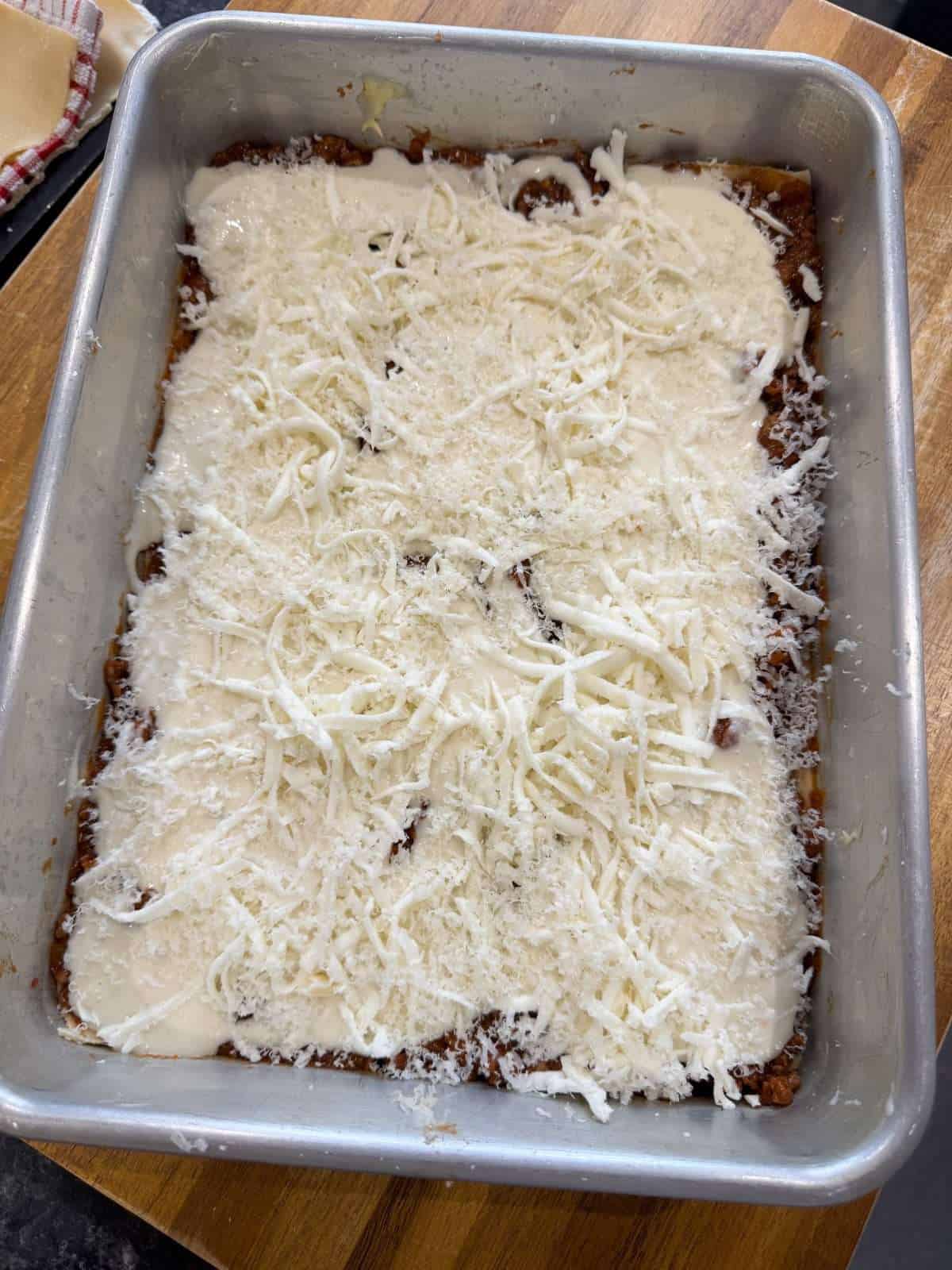
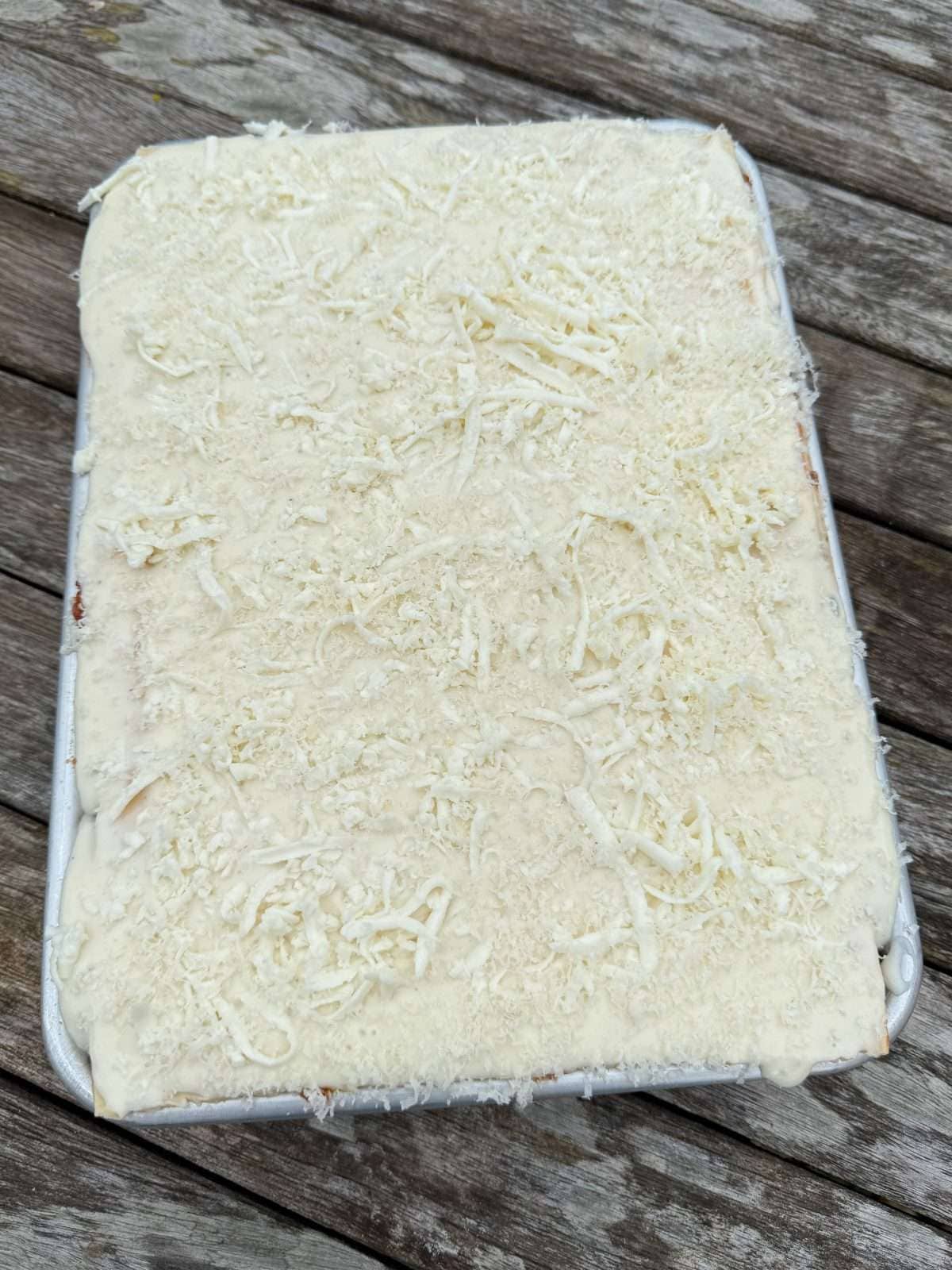
Tips & Tricks
- Let your ragù chill in the fridge overnight before using. This gives the flavours chance to develop!
- To give the ragù the best flavour & texture, use a mixture of beef & pork mince.
- Sprinkle some grated low moisture mozzarella & parmesan cheese between the lasagne layers, for extra flavour. For a more authentic lasagne, you could use ricotta instead.
- Sprinkle plenty of grated cheese on top of your lasagne, to get that classic crispy, golden top!
- Blend roasted garlic into the bechamel sauce, to give your lasagne a deeper flavour. This is perfect for garlic lovers.
- Let your lasagne stand for at least 10 minutes before serving. This gives the lasagne a chance to firm up, which helps it hold its’ shape when you cut it into portions.
Frequently Asked Questions
Yes, lasagne can be made ahead of time, although once assembled it’s best cooked within a day or two. The ragù & bechamel can both be made a couple days in advance & stored in the fridge.
Yes, dried lasagne sheets can be used instead of fresh ones. Dried lasagne sheets don’t need to be blanched & can be used to make lasagne straight from the packet.
After cooking, a 10-15 minute rest firms the lasagne up which helps it keep its’ layers when you cut it into portions.
Although it’s not essential to blanch lasagne sheets before using them for lasagne, I find that par cooking fresh lasagne sheets makes them easier to work with & will form more even layers in your lasagne.
Leftover lasagne needs to be stored in the fridge & is best eaten within a couple of days.
The best way to reheat leftover lasagne is to bake it covered in foil in a 180°c/356°f oven until piping hot. If you take the internal temperature of the filling, it should be at least 75°c/167°f. Alternatively, you can microwave individual portions of lasagne until piping hot.
Cooking Lasagne In An Aga
With all of my recipes, I include cooking instructions for conventional ovens, fan ovens & also Agas. Here’s how to cook this recipe in an Aga…
For the ragù, brown the meat & deglaze the pan using the boiling plate then move over to the simmering plate after you add in the tomatoes. Simmer for 20 minutes on the simmering plate then cook in the simmering oven for 3-4 hours.
Cook the bechamel on the simmering plate & blanch the lasagne sheets on the boiling plate. Cook the lasagne in the baking oven, on the bottom set of runners.
Equipment Used
Please note that these are affiliate links & I may make a small commission if you make a purchase using these links, at no extra cost to you. For more information, click here.
More Dinner Recipes To Try!
- Black Garlic Pork Belly Porchetta
- Leftover Roast Chicken Ramen
- Reverse Seared Fillet Steak
- Roasted Butternut Squash Risotto With Sage Brown Butter
- Goose Fat Jacket Potatoes
- Coq au Vin
If you have enjoyed this roasted garlic lasagne recipe, it would mean a lot if you could leave a review & rating. And if you’d like to stay up to date with future recipes, follow us on Instagram & TikTok!
Roasted Garlic Lasagne (Deep Dish)
Equipment
- 9"x13" Baking Tin
- Food Processor
- Pasta Machine
- Large Saucepan
- Cheese Grater
- Stick Blender
- Microplane
- Rolling Pin
- Digital Food Probe
Ingredients
Ragù Bolognese
- 2 tbsp Vegetable Oil
- 500 g Beef Mince
- 500 g Pork Mince
- 250 g Smoked Pancetta (Or Streaky Bacon)
- 2 White Onions (Peeled & Finely Diced)
- 3 Large Carrots (Peeled & Finely Diced)
- 4 Sticks Of Celery (Finely Diced)
- 6 Garlic Cloves (Grated)
- 2 tsp Finely Chopped Rosemary
- 2 tbsp Tomato Paste
- 400 ml Red Wine
- 800 g Tinned Tomatoes (2 Tins – See Notes)
- 2 Beef Stock Cubes
- 250 ml Whole Milk
- 2 Bay Leaves
- 2 tbsp Worcestershire Sauce
- 2 tsp Balsamic Vinegar
Pasta Dough
- 400 g 00 Flour (See Notes)
- 3 Large Eggs
- 6 Egg Yolks
- Semolina (For Dusting The Pasta Sheets)
Roasted Garlic Bechamel
- 2 Bulbs Of Garlic
- 100 g Unsalted Butter
- 100 g Plain Flour
- 1 Litre Whole Milk
- 300 ml Chicken Stock
- 100 g Parmesan (Grated)
- Nutmeg (Grated)
To Assemble
- 400 g Low Moisture Mozzarella (Freeze For 30 Minutes Before Using)
- 50 g Parmesan
Instructions
Ragù Bolognese
- Set a large saucepan over a medium-high heat, leave to heat up for a minute or so then add in the diced pancetta. Fry, stirring regularly until crisp & golden then use a slotted spoon to transfer the pancetta to a bowl.Leave the rendered fat in the pan!
- Add the beef mince into the pan then fry, stirring frequently until well browned. This will take 5-10 minutes. Once cooked, use a slotted spoon to transfer the mince to the pancetta bowl, leaving any fat in the pan. Repeat the browning process with the pork mince, transferring it to the bowl once browned as well.
- Turn the heat down to medium then add in the diced onion, carrot & celery. Season with a pinch of salt then cook for 4-5 minutes, until soft, stirring frequently. Stir in the grated garlic & chopped rosemary then cook for another minute.
- Add in the tomato paste then cook for 4-5 minutes, stirring almost constantly then stir the mince & pancetta back in.Cook the tomato paste until it darkens in colour. This caramelises it, adding extra flavour to our sauce.
- Pour in the red wine, deglaze the pan then cook for 3-4 minutes, until almost completely reduced.To deglaze the pan, scrape the bottom with a spatula/wooden spoon to release any browned bits that are stuck on.
- Add in the tinned tomatoes & the stock cubes. Fill the empty tomato tins with water & add into the sauce as well. Cook for a minute or two, until warm.
- Next, gradually add in the milk whilst stirring then add in the bay leaves and season with salt & pepper. Bring the sauce to a gentle simmer then cook on the stove for 2-3 hours, until thick and most of the liquid has evaporated.Make sure to stir the sauce every so often!
- Once the sauce is cooked, stir in the Worcestershire sauce & balsamic vinegar then give it a taste, to check the seasoning. Stir in more salt & pepper as needed, then take the pan off the heat & leave to cool.If the sauce tastes slightly bitter, stir in another teaspoon of balsamic vinegar or a teaspoon of caster sugar.
- Once cool, transfer the ragu to a container then chill in the fridge overnight before using.This improves the flavour!
Pasta Dough
- Add the flour, eggs & yolks into a food processor then pulse until a rough dough forms. Tip the dough out onto a clean work surface then knead by hand until smooth. This will take 15-20 minutes.
- Wrap the pasta dough in clingfilm & leave in the fridge for at least a couple of hours but overnight is best.
Roasted Garlic Bechamel
- Preheat an oven to 180°c/160°c fan (356°f/320°f).
- Lightly trim the tops off each bulb of garlic, to expose the cloves then place each bulb onto its' own sheet of foil. Drizzle the garlic with olive oil, season with salt & pepper then roast in the preheated oven for 45 minutes – 1 hour, until the cloves are golden brown & soft. Once cooked, let the garlic cool whilst you make the bechamel.
- Next, add the butter into a large saucepan, set over a medium heat, cook until melted then stir in the flour & cook out for 1 minute.
- Pour a third of the milk into the roux, whisk until smooth then cook out until thick, stirring/whisking regularly. This will take 2-3 minutes over a medium heat.
- Once thick, pour half of the remaining milk into the pan then continue cooking until thickened again. Repeat this process with the rest of the milk, making sure to whisk/stir the sauce frequently to keep it from catching on the bottom of the pan.
- Next, stir the chicken stock into the bechamel then turn the heat down to low & cook until the sauce has thickened for a final time. If you give it a taste, it should taste cooked out, not like flour!The bechamel should be thick enough to coat the back of a spoon once cooked.
- Once the sauce is cooked, turn the heat down to low, stir in the grated parmesan, to melt then add in grated nutmeg, to taste. Season the bechamel with salt & pepper then take the pan off the heat.
- Next, squeeze the roasted garlic out of the skins then use a stick blender to blend roasted cloves into the sauce then set to one side. You can add as much of the roasted garlic into the bechamel as you like!If you haven't got a stick blender, use a jug blender instead! I'd recommend adding at least a bulb of garlic into the sauce but feel free to make it as garlicky as you like.
Lasagne Sheets
- Cut the pasta dough into 4 pieces then use a rolling pin to roll out one of the pieces of dough so that it's thin enough to pass through a pasta machine. Cover the remaining pasta dough with clingfilm to stop it from drying out.
- Next, roll the dough through your machine's widest setting. If the dough needs to be neatened up, fold the edges into the middle so that the paste is the same width as the pasta machine then roll it out through the widest setting for a second time.
- Continue rolling out the pasta, working your way through the settings until the pasta is 1mm thick. Make sure to roll the pasta out twice on each setting.I took my pasta to setting no.6 but it's best to measure the pasta with a ruler as pasta machines can vary.
- Next, cut the rolled out pasta into sheets the same width as your baking tin. Dust the lasagne sheets with semolina then place onto a baking tray. Repeat the rolling out process with the remaining pasta dough. You should get around 10 lasagne sheets in total.Any trimmings can be re rolled! The semolina stops the lasagne sheets from sticking together but if you haven't got any, dust them with flour instead then separate the layers with baking paper.
- Once all of the pasta has been rolled out, set a large pan of lightly salted water over a high heat then bring to the boil. Cook the lasagne sheets for 1 minute then immediately place into a bowl of ice & cold water. A pair of tongs or a slotted spoon works best for taking the pasta out of the water.It's best to blanch in batches of 3-4 sheets at a time so that they don't stick together. We don't want to fully cook the pasta at this point, just lightly blanch as it makes assembling the lasagne easier.
- Drain the pasta then place onto a tray lined with a tea towel & pat dry.
Assembly & Baking
- Preheat an oven to 180°c/160°c fan (356°f/320°f).
- Grate the mozzarella with a box grater then set to one side.
- Grease a 9"x13" baking tin with butter then spread a small amount of the ragù on the bottom. This stops the lasagne sheets from moving around.
- Top the ragù with a single layer of lasagne sheets then spoon a quarter of the remaining ragù on top, spreading it out into an even layer that completely covers the pasta.
- Next, spoon a generous amount of the bechamel over the ragù then top with a sprinkle of grated mozzarella & plenty of grated parmesan (use a microplane to grate the parmesan over the lasagne!).You'll need to use roughly 1 fifth of the bechamel, grated mozzarella & parmesan per layer.
- Continue layering up the lasagne in the same order until you've used up all of the pasta sheets, ragù, bechamel & cheese. The top layer should just be bechamel & grated cheese (no ragù).There should be five layers of lasagne sheets, ragù (including the bottom layer) & bechamel.
- Place the tin of lasagne onto a baking tray then bake in the preheated oven for 45 minutes – 1 hour until the top is crisp & golden brown and the sauces are bubbling.The tray is there to catch any sauce that may bubble over!
- Once cooked, let the lasagne stand for at least 10 minutes before cutting & serving. This helps the lasagne hold its' shape.

